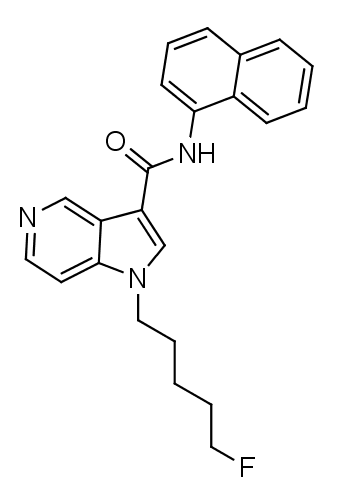Summary
5F-PCN, also identified as 5F-MN-21, belongs to the category of azaindole-based synthetic cannabinoids. It is presumed to possess potent agonistic effects on the CB1 receptor and has found its way into online markets as a designer drug. Notably, it shares a close chemical relationship with NNE1.
An intriguing aspect to consider is the metabolic processes involving 5F-PCN. Given the documented release of amantadine (and its presence as an impurity) in the related compound APINACA, there is suspicion that metabolic hydrolysis of the amide group in 5F-PCN might result in the liberation of 1-naphthylamine, a known carcinogenic substance. This raises concerns about potential health risks associated with this compound.
| Identifiers | |
|---|---|
| IUPAC name | |
| CAS Number | 2219332-48-4 |
|---|---|
| PubChem CID | 125181244 |
| ChemSpider | 34450856 |
| UNII | Q7GH2GGJ3E |
| Chemical and physical data | |
| Formula | C23H22FN3O |
| Molar mass | 375.447 g·mol−1 |

Legal status
Sweden’s public health agency suggested to classify 5F-PCN as hazardous substance on November 10, 2014.
FAQ
1. What is 5F-PCN?
5F-PCN, or 5F-MN-21, is a synthetic cannabinoid based on the azaindole structure. It is presumed to act as a potent agonist of the CB1 receptor and has been marketed as a designer drug.
2. How is 5F-PCN typically used?
5F-PCN is commonly used recreationally, often like traditional cannabis products. Users may smoke, vaporize, or ingest it.
3. What are the potential effects of 5F-PCN use?
The specific effects of 5F-PCN may vary from person to person. It is believed to produce psychoactive effects similar to those of natural cannabinoids, potentially affecting mood, perception, and cognition.
4. Is 5F-PCN legal to purchase or possess?
Legal status varies by country and jurisdiction. It’s essential to be aware of local laws and regulations regarding the possession and use of 5F-PCN, as it may be considered a controlled substance in some areas.
5. Are there health risks associated with 5F-PCN?
There is limited research on the health risks of 5F-PCN, but like other synthetic cannabinoids, it may pose potential dangers. Some synthetic cannabinoids have been linked to adverse effects on mental and physical health.
6. What is the concern about metabolic hydrolysis and 1-naphthylamine?
Metabolic processes of 5F-PCN may lead to the release of amantadine and, as a concern, 1-naphthylamine. The latter is known to be a carcinogen, raising health-related apprehensions.
7. Is 5F-PCN similar to natural cannabis?
While 5F-PCN is designed to mimic the effects of natural cannabinoids, it is a synthetic compound with a potentially different pharmacological profile. Users should exercise caution and be aware of the differences.
8. Where can I find more information about 5F-PCN?
For further information, consult authoritative sources, scientific literature, and local regulatory agencies to understand the legal status and potential risks associated with 5F-PCN.
References
- Explore insights about 5F-PCN on Cayman Chemical’s website. Stay informed about this synthetic cannabinoid.
- Delve into research by Blaazer AR et al. from October 2011, which delves into the design, synthesis, and biological activity of novel indole and azaindole (pyrrolopyridine) cannabinoid receptor agonists. Discover the intricacies of this compound.
- Learn about potential regulatory changes as “Cannabinoider föreslås bli klassade som hälsofarlig vara” (Cannabinoids are proposed to be classified as harmful substances) according to Folkhälsomyndigheten. Stay updated on evolving regulations related to cannabinoids.